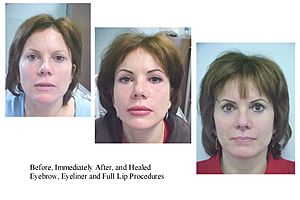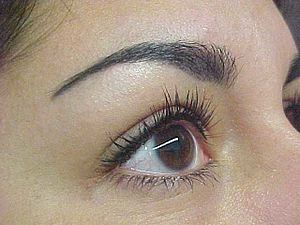Permanent makeup facts for kids
Permanent makeup is a special way of using tattoos to create designs that look like regular makeup. It's also called permanent cosmetics or cosmetic tattooing. Instead of putting makeup on every day, people get tiny tattoos on their skin to make it look like they're wearing eye-lining, lip color, or even eyebrows.
This technique is used on the face, lips, and eyelids. It's great for people who want to save time or those who have lost their eyebrows due to age, illness (like a condition called alopecia totalis where hair falls out), or medical treatments such as chemotherapy. It can also help hide scars or light patches on the skin, like those from a condition called vitiligo.
Contents
History of Permanent Makeup
The idea of permanent makeup isn't new! The first time it was officially recorded was in 1902. A famous tattoo artist in the U.K., Sutherland Macdonald, offered a treatment he called an "all-year-round delicate pink complexion" for cheeks.
In the 1920s, this trend became popular in the United States. People started getting "electrically tattooing a permanent complexion or blush on the face." By the 1930s, another tattoo artist named George Burchett said that some beauty salons would even tattoo women without them knowing! They would offer it as a "complexion treatment" and secretly inject dyes under the skin.
How Permanent Makeup Looks Over Time
Long-term Results
Permanent makeup can look good for many years, but it might start to fade over time. How long it lasts depends on the person. The color stays in your skin, but things like being in the sun a lot can make it fade faster.
If the makeup is very natural-looking, it might need a touch-up sooner than bolder designs. Your lifestyle, like spending a lot of time outdoors gardening or swimming, can also affect how long the color lasts. Even your natural skin tone can change how the color looks over time.
Things That Can Go Wrong
Sometimes, people might not be happy with their permanent makeup. This can happen if they change their mind about having a tattoo, if makeup styles change, or if the color fades unevenly.
Removing Permanent Makeup
Just like regular tattoos, permanent makeup can be hard to remove. If someone wants to take it off, they might use special laser resurfacing treatments, or methods that gently remove layers of skin (like dermabrasion). Sometimes, it might even need to be surgically removed.
Possible Problems and Side Effects
Like any tattoo, permanent makeup can have some risks. These can include:
- Migration: This is when the color spreads a little beyond where it was supposed to be. It can happen if the technician works too much on one area, especially around the eyes.
- Allergies: Some people might have an allergic reaction to the colors used.
- Skin problems: This could include scars, bumps (called granulomas or keloids), or the skin cracking, peeling, or blistering.
- Infection: If the tools used are not clean, there's a risk of getting a serious infection. It's very important that technicians use clean, sterile tools.
- Difficulty removing: As mentioned, it can be hard to remove, especially from delicate areas like eyelids or lips, without leaving marks.
To stay safe, it's important to make sure the technician follows all safety rules and uses clean equipment. They should also be well-trained to avoid problems like color migration.
Very rarely, some people with permanent makeup have felt swelling or burning when they had an magnetic resonance imaging (MRI) scan. However, this is usually because of older, lower-quality colors that contained certain metals.
Technicians often use numbing creams before the procedure. It's important that these creams are used safely to avoid any problems.
The color of permanent makeup can change over time for many reasons. These include:
- The type of colors used.
- How the tattoo artist applied the makeup.
- Things about the person's own body.
- Things in the person's environment, like sun exposure, or medicines they might be taking.
See also
 In Spanish: Micropigmentación para niños
In Spanish: Micropigmentación para niños
- Microblading
- Hair tattoo



